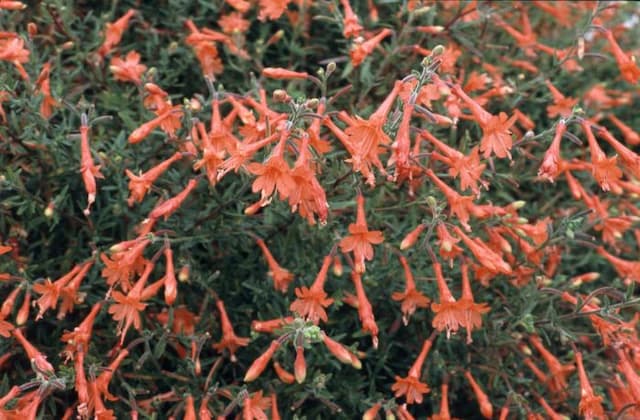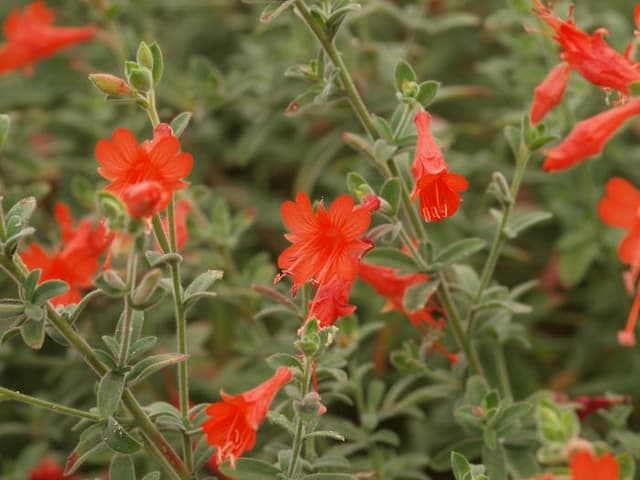Fuchsia Fuchsia 'Valerie Hobbs' (d)

ABOUT
Fuchsia 'Valerie Hobbs' is a delightfully decorative plant known for its attractive and unique flowers. These blossoms are a stunning dual color, typically featuring a pinkish-purple outer layer which gracefully encases a vibrant, violet inner skirt. The petals are long and slender, elegantly hanging down in a teardrop shape that adds a sense of movement and delicacy to the plant's overall appearance. The sepals – the petal-like parts that are at the base of the flowers – usually display a lighter shade of pink, creating a lovely contrast with the darker tones of the purple petals. Adding to its ornamental appeal are the dark green leaves, which are oval-shaped with slightly serrated edges to give the foliage a textured look. The leaves form a bushy backdrop that makes the brightly colored flowers stand out even more pronouncedly. As the plant matures, it becomes a focal point of beauty in any garden space, with its cascading flowers creating a visual spectacle that can give a touch of elegance to the surroundings. Overall, Fuchsia 'Valerie Hobbs' is a charming plant that is highly prized for the decorative flowers that set it apart from other garden varieties.
About this plant
 Names
NamesFamily
Onagraceae
Synonyms
Lady's Eardrops, Fairy Bells, Hanging Fuchsia
Common names
Fuchsia 'Valerie Hobbs'
 Toxicity
ToxicityTo humans
Fuchsias, including the 'Valerie Hobbs' variety, are generally not considered toxic to humans. However, as with any plant, individual reactions can vary, and it is always advisable not to ingest parts of ornamental plants. If ingested in large quantities, there might be a risk of gastrointestinal discomfort, but such instances are rare, and fuchsias are not known for being hazardous.
To pets
Fuchsias, including the 'Valerie Hobbs' cultivar, are not known to be toxic to pets such as dogs and cats. They are generally considered safe, and there are no widely recognized symptoms of poisoning associated with these plants. However, it's always best to prevent pets from eating plants since individual animals might have sensitivities or allergies, and any non-food item can potentially cause gastrointestinal upset if consumed in significant amounts.
 Characteristics
CharacteristicsLife cycle
Perennials
Foliage type
Deciduous
Color of leaves
Green
Flower color
Pink
Height
2 feet (0.61 meters)
Spread
2 feet (0.61 meters)
Plant type
Shrub
Hardiness zones
9
Native area
Central America
Benefits
 General Benefits
General Benefits- Ornamental Appeal: Adds vibrant color and visual interest to gardens with its striking pink and purple flowers.
- Long Blooming Season: Offers a prolonged display of blooms from late spring to early fall.
- Attracts Pollinators: Draws in hummingbirds and butterflies, aiding in pollination of nearby plants.
- Versatility: Suitable for various garden settings including borders, hanging baskets, and containers.
- Shade Tolerance: Unlike many flowering plants, it can thrive in partial shade conditions.
- Easy Propagation: Can be easily propagated from cuttings, making it simple to create more plants.
- Minimal Pruning: Requires only light pruning to maintain shape and encourage blooming.
 Medical Properties
Medical PropertiesThis plant is not used for medical purposes.
 Air-purifying Qualities
Air-purifying QualitiesThis plant is not specifically known for air purifying qualities.
 Other Uses
Other Uses- Fuchsia 'Valerie Hobbs' can be used in floral arrangements due to its vibrant blooms that add a splash of color. The flowers hold up well when cut and placed in water.
- The plant's berries are edible and can be used to make jams or jellies, though they are not as commonly consumed as other fruit.
- Being both beautiful and attracting pollinators, Fuchsia can be planted to support local bee and hummingbird populations.
- When dried, the blossoms of the Fuchsia can be used to create natural dyes for fabrics or crafting projects.
- Fuchsia plants can be used in hanging baskets to create vibrant, draping displays for patios and porches.
- The small shrub can be utilized in fairy gardens due to its miniature size and colorful, fairy-like flowers.
- In areas where privacy is needed, a row of Fuchsia plants can form a low, flowering hedge.
- Fuchsia can be incorporated into educational gardens that teach about the care of different types of flowers, due to its distinct cultivation needs.
- The plant can act as a living ornament during festive seasons like Christmas, with its brightly-colored flowers adding to the decor.
- Fuchsia 'Valerie Hobbs' can be used in butterfly gardens as their flowers attract various species of butterflies aside from bees and hummingbirds.
Interesting Facts
 Feng Shui
Feng ShuiFuchsia is not used in Feng Shui practice.
 Zodiac Sign Compitability
Zodiac Sign CompitabilityFuchsia is not used in astrology practice.
 Plant Symbolism
Plant Symbolism- Grace: The fuchsia plant, with its delicate teardrop-shaped flowers, often symbolizes grace and elegance due to its poised appearance.
- Confiding Love: In the Victorian language of flowers, fuchsia is said to represent confiding love, likely because of its heart-like shape and rich, vibrant colors that are often associated with deep feelings.
- Good Taste: Fuchsia's unique flowers and its blend of two or more colors can express the sentiment of good taste, both as a commendation of personal style and an acute appreciation for beauty.
- Overflowing Abundance: The prolific blooming of the fuchsia can symbolize overflowing abundance, reflecting the plant's generous production of flowers.
- Amenability: As it is a plant that can adapt to various environments when cared for properly, fuchsia can symbolize amenability and readiness to adjust to situations.
 Water
WaterLady's eardrops should be watered regularly to keep the soil evenly moist but not soggy. During the active growing season in spring and summer, watering may be required every few days, while in fall and winter, watering frequency should be reduced. It's best to check the soil moisture by feeling the top inch; if it's dry, it’s time to water. Generally, about 16 to 32 ounces per watering session should be sufficient depending on the size of the pot and the conditions, such as temperature and humidity. Overwatering can lead to root rot, so ensure good drainage.
 Light
LightLady's eardrops thrive in bright, indirect light; direct sunlight can scorch their leaves, particularly in hot summer months. A spot that offers morning sun with afternoon shade or dappled sunlight is ideal. Fuchsia 'Valerie Hobbs' should be protected from the harsh midday sun to prevent damage to the foliage and flowers.
 Temperature
TemperatureLady's eardrops prefer a cooler climate and thrive in temperatures between 50 to 70 degrees Fahrenheit. They can survive temperatures down to about 40 degrees Fahrenheit for short periods, but long exposure to cold or frost can be detrimental. Ideal growing conditions would have daytime temperatures around 60 to 70 degrees Fahrenheit and cooler nights, without drastic temperature fluctuations.
 Pruning
PruningPruning lady's eardrops is crucial for maintaining a bushy plant shape and encouraging more blooms. Prune in late winter or early spring before new growth begins. Remove any dead or damaged branches and trim back one-third of the plant to promote new growth. Pruning can be done every year or as needed to keep the plant looking its best.
 Cleaning
CleaningAs needed
 Soil
SoilFuchsia 'Valerie Hobbs' thrives best in a well-draining soil mix consisting of peat moss, perlite, and loamy soil, with a pH range of 6 to 7.
 Repotting
RepottingFuchsia 'Valerie Hobbs' should be repotted every two to three years to refresh the soil and accommodate root growth.
 Humidity & Misting
Humidity & MistingFuchsia 'Valerie Hobbs' prefers high humidity levels, generally between 60% to 70%.
 Suitable locations
Suitable locationsIndoor
Place in bright, indirect light and keep soil moist.
Outdoor
Hang in partial shade, shelter from strong winds.
Hardiness zone
10-11 USDA
 Life cycle
Life cycleThe life cycle of the Fuchsia 'Valerie Hobbs' begins with seed germination, where the seeds require warm and moist conditions to sprout. Following germination, the seedlings grow into young plants and must be situated in favorable conditions with partial shade and well-draining soil to establish themselves. As the plants take root and mature, they develop their characteristic teardrop-shaped flowers, ranging in color from pink to purple. During the flowering stage, which can last from late spring through fall, regular watering and feeding can promote more vigorous growth and bloom. After the flowering period, Fuchsia 'Valerie Hobbs' can undergo a dormant phase, particularly in cooler climates, where they may lose leaves and appear dead. The plant will then re-emerge in the spring, continuing its cycle, and may require pruning to maintain shape and encourage new growth.
 Propogation
PropogationPropogation time
Spring-Early Summer
Fuchsia 'Valerie Hobbs', commonly known as Lady's Eardrops, is most commonly propagated by stem cuttings. This technique is best performed during the spring to summer months when the plant is actively growing. To propagate, a cutting of about 2 to 4 inches (5 to 10 cm) in length is taken just below a leaf node. The leaves at the bottom half of the stem are removed, and the cutting is then dipped in rooting hormone to encourage root development. The prepared cutting is inserted into a pot filled with a moist, well-draining potting mix. The pot should be kept under indirect light and at a consistent humidity level to facilitate root growth, which generally starts to form within a few weeks. Once the cuttings have established a robust root system, they can be transplanted to their final location.









